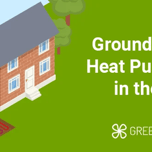Answer these simple questions and we will find you the BEST prices
Which type of solar quotes do you need?
It only takes 30 seconds
100% free with no obligation

Get up to 4 quotes by filling in only 1 quick form

Install a heat pump for less with the BUS grant

We’ve helped over 500,000 homeowners reduce their carbon footprint
- GreenMatch
- Air Source Heat Pumps
- Air Source Heat Pump Performance
Air Source Heat Pump Performance
Historically, air source heat pump systems have been the most widely used due to their relatively low cost, easy maintenance, inexpensive installation and eligibility for incentives. However, they are also prone to limitations, based on the way they function.
To heat the inner space of the home, air source heat pumps absorb outside air and move it inside the building. That limits their performance to a certain extent when the outside temperature drops below freezing. In this article, we'll discuss the different air source heat pump performance types and how to achieve optimal heating in your home.
If you already know that you want a new air source heat pump for your home, we've got you covered. Our team can connect you with up to 4 certified heat pump installers in your area. This saves you from stress and wasting hours of your time trying to find installers by yourself. It also helps you to easily compare local prices so you can feel confident that you're getting the best deal and avoid throwing your hard-earned money down the drain.
Simply click the button below and we'll provide you with up to 4 free, no-obligation quotes.
- Quotes from local engineers
- Payment by finance available
- Save £7,500 with BUS grant
It only takes 30 seconds



What Are SPF and COP?
To assess air heat pump performance, there are a couple of indicators that give information about heat efficiency and seasonal temperature fluctuation dependencies. In a sense, the SPF and COP parameters will help you comprehend air source heat pump limitations and adjust your preferences according to your specific needs.
The interactive graphic below illustrates how the process works. You can click each point to read about the steps in more detail:
Seasonal Performance
Because air source heat pumps move the outside air to heat the internal space of the home, they are dependent on the seasonal fluctuations of the outside temperature. To reflect that dependence, the performance of heat pumps is rated with a Seasonal Performance Factor (SPF). SPF shows the average Coefficient of Performance of a heat pump over a full heating season.
More specifically, the SPF represents the total useful heat that has been generated annually from the heat pump and then divided by the annual electricity consumption. Electricity consumption is related to all other heating solutions that are part of the overall heating system, e.g. underfloor heating.
However, because heat pumps are a renewable heating solution, the heat produced is always higher than the one consumed. For example, if the SPF is 3, the system is expected to give 3 units of heat energy for each one used.
According to EU legislation, SPF of 2.5 indicates the minimum performance that makes the heat pump eligible for the Renewable Heat Incentive (RHI).
Efficiency Performance
The efficiency of a heat pump is measured by their Coefficient of Performance (COP). That is the ratio of heat produced per unit of electricity consumed when pumping the heat. Efficiency performance tends to decrease during periods of severe cold.
For comparison, in mild weather COP can be about 4.0, but when the temperature drops to 0°C, the COP can also decline to 2.5. On average, the COP of typical heat pumps has a seasonal variation of about 2.5-2.8. However, there are heat pump models having higher performance in mild climates.
When selecting a heat pump, keep in mind that the higher the ratio, the more efficient the unit and the more efficient the heat delivery. A COP value of 3 means that you get 3kWh of heat output for every 1kWh of electricity used to run the pump. Higher COP values represent a heat delivery that is relatively more efficient.
For example, a COP value of 4 means that you get 4kWh of heat output for every 1kWh of electricity used to run the pump. Keep in mind, that the COP mentioned by manufacturers is measured under test conditions and you should treat it with caution.
Take into consideration also that the type of air source heat pump will affect the range of COP. Air to air heat pumps have usually higher COP than air to water heat pumps, but this doesn't always mean that they can cover all your heating needs more effectively. In the video below, we compare the two types based on their efficiency, as well as cost, installation and possible savings you can make.

Improve the Air Source Heat Pump Performance
When the outside temperature drops below 5°C, remember to remove the ice that accumulates on the evaporator, due to the moisture generated in the air condensing. Because the ice decreases the efficiency of the coil by reducing its ability to transfer heat to the refrigerant, remove it and switch on ‘defrost mode’ by reversing its action. To melt the ice, direct the hot gas to the outdoor coil and switch off the evaporator fan.
No matter that this usually is not mentioned on the manufacturer’s COP, when you remove the ice, the SPF will also decrease. This way, you will minimise the amount of wasted energy and improve the operating efficiency of the heat pump by 5-10%.
Remember That…
To achieve optimal heating of the space in your home, remember that before installing a heat pump you need to insulate the building. That will improve the living conditions, despite temperature fluctuations.
Before you start installing the heat pump, remember to check your eligibility for government heat pump grants and incentives, that will considerably reduce the financial burden of purchasing due to the cost of air source heat pumps in the UK and installing them. Make sure that your building complies with the building limitations and requirements of local authorities.
An Energy Performance Certificate (EPC) is required before contacting a heat pump installer in the UK, especially if you plan to apply for a grant. EPCs tell you the energy efficiency of your property by rating it from A (very efficient) to G (inefficient) and can also indicate the expected heating costs and emissions of your property.
After arranging for an EPC assessment with an accredited assessor, you can use GreenMatch to get fair quotes for a new efficient heating system. If you’ve recently purchased a property, you may still have a valid EPC, which can also be confirmed through the government portal.
In the end, remember that by installing a sustainable heating solution like an air source heat pump, you can reduce the carbon footprint of your household on the environment and make a personal contribution for the preservation of the life on the planet. If you're ready to make your home more environmentally friendly today, we can help you find a new heat pump quickly so you can start reaping the benefits.
At GreenMatch, we can provide you with up to 4 quotes from qualified heat pump installers available in your area. This means you can avoid researching and contacting installers yourself, saving you hours of your precious time. It also means that you can avoid stressing over the installers' capabilities, as they have all been vetted by us.
Click the button below to get your free, non-binding quotes now.
- Quotes from local engineers
- Payment by finance available
- Save £7,500 with BUS grant
It only takes 30 seconds



We strive to connect our customers with the right product and supplier. Would you like to be part of GreenMatch?





